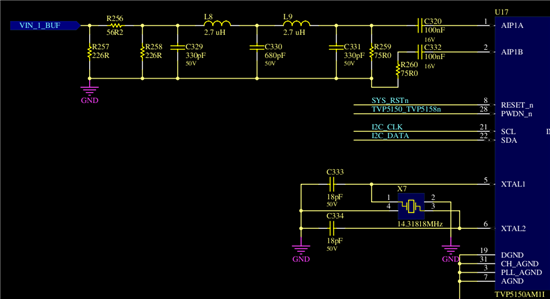Hi, I'm doing board bringup on a custom board to capture and encode h264 video from on a dm365, from a NTSC camera via a tvp5150 decoder.
- DM365 custom board, with TVP5150 YOUT to a 74CBTLV16210DL switch, to DM365 YIN
- NTSC input from camera to TVP5150
- modified DMAI based recorder test application
- YCINSWP added: ccdcfg |= CCDC_YCINSWP_YCBCR in dm365_ccdc.c driver.
- Using tvp5150 driver from DVSDK3.0
The recorded video has some vertical line noise, and some pulsing intensity artifacts. Attached is a sample recorded video.
Any ideas what settings might be causing this sort of problem? It appears to be some sort of misconfiguration, but I have not been able to pinpoint it. There was some flywire rework to the lines between the TVP5150 and the switch, but as this is a digital signal, i expect that it would not introduce video noise of this sort.
Regards,
Mitch Rybczynski
added some debug output and configuration changes to the tvp5150.c, dm365_cdcc.c, and vpfe_capture.c:
tvp5150 1-005c: tvp5150am1 detected. tvp5150 1-005c: MTR: Selecting video route: route input=0, output=0 => tvp5150 input=0x0, opmode=0x0 tvp5150 1-005c: tvp5150 Set video std register to 2. ccdc: writing ccdcfg: 0x812 ccdc: configuring SDOFST for 0x249 - two field interleaved vpfe-capture vpfe-capture: Setting video standard: 45056 vpfe-capture vpfe-capture: vpfe_config_image_format() MTR: hard coding NTSC 720x480, V4L2_BUF_TYPE_SLICED_VBI_CAPTURE, V4L2_FIELD_INTERLACED; for tvp5150 vpfe-capture vpfe-capture: vpfe_config_ccd_image_format() pix_fmt is configured to: UYVY vpfe-capture vpfe-capture: hard coding V4L2_PIX_FMT_UYVY: UYVY vpfe-capture vpfe-capture: successfully set pix format UYVY in ccdc vpfe-capture vpfe-capture: set frame format: 1, ret: 0 vpfe-capture vpfe-capture: setting fmt.fmt.pix.bytesperline: 1440 fmt.fmt.pix.height: 480 and sizeimage: 691200 MTR vpfe_lookup_pix_format() returning pix_fmts[] for pix_format: NV12 vpfe_check_format found pix_fmt: NV12 vpfe-capture vpfe-capture: width = 720, height = 480, bpp = 1 vpfe-capture vpfe-capture: vpfe_check_format(): returning pix_fmt: NV12, adjusted width = 720, height = 480, bpp = 1, bytesperline = 736, sizeimage = 529920 vpfe-capture vpfe-capture: vpfe_s_fmt_vid_cap(): MTR: v4l2_format type: 1 MTR vpfe_lookup_pix_format() returning pix_fmts[] for pix_format: NV12 vpfe_check_format found pix_fmt: NV12 vpfe-capture vpfe-capture: width = 720, height = 480, bpp = 1 vpfe-capture vpfe-capture: vpfe_check_format(): returning pix_fmt: NV12, adjusted width = 720, height = 480, bpp = 1, bytesperline = 736, sizeimage = 529920 ccdc MTR: writing ccdcfg: 0x812 ccdc MTR: configuring SDOFST for 0x249 - two field interleaved ipipe_set_resizer, resizer - A enabled vpfe-capture vpfe-capture: VPFE Start Capture


